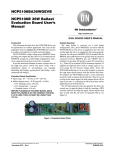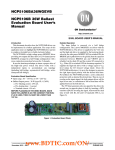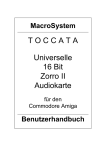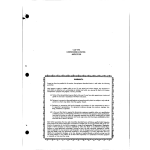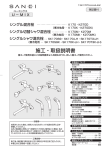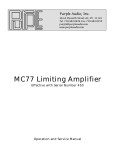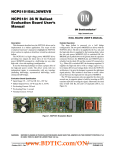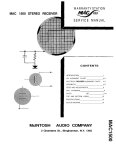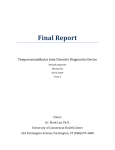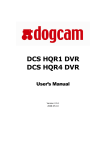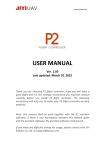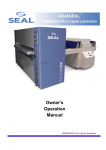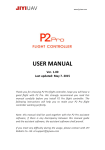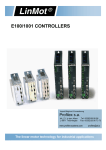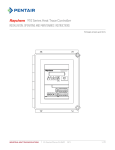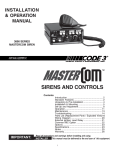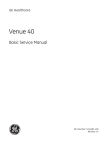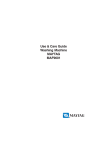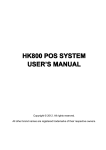Download Purple Audio Inc.
Transcript
Purple Audio Inc. MC76 Peak Limiter Effective with serial number 001 The MC76 is a Monaural FET Peak Limiting Amplifier Units of this type have been in wide use for many years to provide precise and automatic control of peak signal levels in recording studios, disc mastering facilities, broadcast stations and sound reinforcement applications. Operation of the MC76 Limiting Amplifier should be very familiar to those who have used similar devices in the past. UNITS FEATURE: *Discrete Transistor Electronics *Transformer Balanced XLR Inputs and Outputs *Zener Shunt Regulated Power Supply *Single Element Class A Output Amplifier *Compression Ratios 4:1, 8:1, 12:1 and 20:1 *Fast Attack Time 20 microseconds to 800 microseconds *Release Time 50 milliseconds to 1.1 second *Gain 45dB (full gain with no limiting) *VU Meter for output level and gain reduction indication *Built In Stereo Interconnect with offset adjustment *Heavy Gauge Stainless Steel Enclosure *Purple Anodized Aluminium Front Panel *120/240 volt operation *3 Year Warranty UNPACKING AND INSTALLATION Your MC76 was packed with care at the factory. The packaging was designed to protect the unit from rough handling. However, once the unit leaves us, it may pass through the hands of those who have no idea what is in the box, may not be happy with work, may like to throw things, don't care.... etc. Despite the heavy duty carton and foam blocks the unit was packed with, we recommend you inspect the box and its contents immediately for any sign of damage that may have occurred in transit. If there is damage, you should save all the packing materials and contact your vendor and shipper immediately. We recommend you keep the packing materials. Murphy’s law states that once you throw away the box the likelihood you will need it back will increase in proportion to the square of the distance from your service center multiplied by the cost of replacement packing materials. The carton we ship out contains: *One MC76 Limiting Amplifier *This Manual *One six foot (two meters) IEC Cable *Warranty Card The unit can operate safely and within specification over a range of ambient temperatures from 0°C (+32°F) to +50°C (+122°F). Humidity is generally not a factor unless there is condensation. One way to avoid condensation is to keep the ambient temperature reasonably constant. The unit can be powered from either 100-125 volt or 200-250 volt AC Mains at a line frequency of 50 or 60 Hz. The operating voltage should be set BEFORE you plug the unit in. The power inlet module integrates the voltage selector into the fuse holder. The selected voltage (115V or 230V) will show through a smallwindow in the flip down “door” that covers the fuse holder. The unit should be supplied with an IEC cable applicable to your locality. The fuses and voltage selection should be set up for you, BUT NEVER ASSUME!! Fuses: At 115 Volts the unit should be fused for 1/8 Amps At 230 Volts the unit should be fused for 1/16 Amps Signal Connections are made via standard XLR connectors. XLR Pin Assignments: PIN 1 = Chassis, Earth, Ground PIN 2 = Signal "Hot", Positive, ø+ PIN 3 = Signal "Cold", Negative, ø- Wiring systems vary from facility to facility. PIN 1 may or may not be used to terminate a shield or drain wire. In general this pin and the shield or drain wires connected to it are not to be used to “Ground” or “Earth” the unit. Shields and Drain Wires should NOT carry current and are generally connected at only one end of any given wire. For your convenience and to assure that the chassis can beeasily grounded (earthed) there is a Chassis Ground Lug on the back of the unit and the center pin of the IEC power inlet is connected to the chassis as well. UNPACKING AND INSTALLATION - continued PINS 2&3 of the input and output XLR connectors must be connected to get signal in and out of the unit. Since the inputs and outputs are transformer balanced there is no problem unbalancing either the input or output or both. Because the input attenuator is ahead of the input transformer taking PIN 3 of the input XLR to signal common is the preferred way to unbalance the input. To maintain consistent phase from input to output connection of PIN 3 to audio common is the preferred way to unbalance the output unless you WANT to flip the phase. BRIEF OPERATING INSTRUCTIONS Once the unit is set to the correct line voltage, plugged in and audio connected... 1) Set Input and Output Gain controls straight up to 12 O’clock. Do the same for Attack and Release controls. 2) Pick a Ratio - a good place to start is 12:1 but any of the four available will do - higher ratios will give a harder limiting effect while lower ratios will provide a softer compression effect. 3) Set the meter select to GR or Gain Reduction. 4) Run the program material of your choice through the MC76. 5) Observe the amount of Gain Reduction on the meter. Adjust Input Gain and observe how GR indication changes and listen to how the program material sounds. 6) Select Meter to +4 (or +8 if 0VU in your facility is referenced to +8dBu) and look at the level coming out of the MC76. Set the Output Gain to a level that makes sense for you and then return the Meter Select to GR after you set the output level. 7) Experiment Note 1: Attack and Release times are quicker with clockwise rotation of controls. If you set the release too quick the bass frequencies can modulate gain limiting at an audio rate. This may not sound good on intruments like a bass guitar. Fast release does sound good in many applications such as where bass frequencies are not a major component. Note 2: If you turn the Attack control counter-clockwise until it clicks, this will disable the limiter leaving only the gain which can be substantial. (Be mindful of your speakers!) Note 3: Note 4: You CAN push more than one Ratio button at a time. The XLR connectors are wired Pin 2 hot. Note 5: The VU meter should be left in GR mode during normal operation as it is unbuffered and will add distortion to the signal if left hanging across the output. OPERATING INSTRUCTIONS The Attack Time of the MC76 is the time it takes for the detector circuitry and FET to respond to a signal as it exceeds the threshold. This parameter is variable by the user since the adjustment may have a significant effect on the sound of the program material. The Release Time may be defined as the time it takes the limiter to return to its normal gain, after the signal which has caused the gain reduction has dropped below the threshold. The release time is variable for the same reason that Attack time is and can substantially alter the sound of the program material passing through the MC76. Together, Attack and Release times will define much of the sound or coloration in any given application. METER ZERO ADJUST (Allow 15 minutes warm-up) Push the "GR" meter function switch. The VU meter should read "0" on the VU scale since the limiting function is disabled (the attack control knob is turned to OFF). If the "0" indication has drifted beyond + or - 1 dB, it should be adjusted. This may be done through the hole in the front panel located between the Input and Output level controls using a small screwdriver. The trim pot is straight back through this access hole and requires a small slotted screwdriver - service techs in the USuse a popular Xcelite screwdriver called a "greenie". STEREO INTERCONNECTION OF TWO MC76 UNITS Two or more MC76 limiters my be connected for stereo or multi-channel operation as follows. First remove signals from both limiters and disable gain reduction by rotating the Attack controls fully CCW. Set the meter function switches for "GR" mode. Connect one MC76 to the other by plugging a 1/4” “mono” patch cable (like a short guitar cable) from the offset jack on one unit to the direct jack on another unit. Adjust the stereo offset on the MC76 whose offset jack is used until both meters read zero. If the meters cannot be zeroed, reverse the polarity (or “phase” on early units) and the meters can then be zeroed. The same compression ratio should be selected in both units. Each limiter should be set-up separately for threshold and output level before being linked together for stereo operation. When the two MC76 limiters are interconnected, the Attack controls on both units will interact, as will the Release controls. Since the timing capacitors are in parallel, the fastest attack time will be double that of a single unit. Attack time on either limiter can be adjusted separately to control both units. Maximum release time is the same as on an individual unit. A good procedure is to set the release control on one MC76 limiter to maximum and to use the release control on the other unit to control release time. A given pair of MC76's will normally track properly through at least 10 dB of gain reduction. In some instances, transconductance of the two FET's (Q1) will differ to the extent that equal gain reduction will not be obtained as limiting is increased. This condition is more apt to be present in MC76's with widely different serial numbers, as the FET's within the same factory production run are usually well matched. Should this anomaly be observed, it will be necessary to select FET's for Q1 which match more closely in transconductance. This should be handled at the factory. DESCRIPTION The MC76 is a gain limiting amplifier. Units of this type have been used for many years to provide precise and automatic control of peak signal levels in recording studios, disc mastering facilities, broadcast stations and sound reinforcement applications. Gain reduction in the MC76 is accomplished using a Field Effect Transistor (FET) as a voltage controlled variable resistor shunt. The FET is the first active component in the signal chain. Large amounts of limiting can occur without large increases in distortion. There are four compression ratios that can be used to best complement the program material and the specific application. Attack Time is continuously adjustable from less than 20µsec to 800µsec. The fast attack time response is independent of peak frequency content or duration. Over the audio band the full limiting action will stabilize in under a half cycle. Release time is continuously variable from 50msec to 1.1sec. Release time is defined as the time it takes for the gain to recover to within 63% of the normal non-limiting gain. Provisions have been made for the interconnection of multiple MC76 Limiters. When connecting multiple limiters (usually two for stereo) it is necessary to set the balance between the two connected units. This linking circuit is built in to every MC76 and there is a balance or offset control on the back panel next to the interconnection jacks. GENERAL DEFINITIONS Compressors and Limiters are used in many applications. A technical application for these devices occurs when the dynamic range of program material is too large to be processed by succeeding equipment, or when the peak-to-peak amplitude is too large for the headroom of the following equipment. Compressors and Limiters are used to reduce the dynamic range of the program material so it "fits" through the equipment and systems that follow. Good examples are broadcast transmitters and public address systems. A non-technical application occurs as a production or creative tool. Any device that changes dynamic range will cause some subjective change in the sound of the program material. Reducing dynamic range of an individual track in a multi-track recording and making it more consistent makes it easier to control in the mixdown process. The applications as a production tool are limitless. The two different names (Compressors and Limiters) generally refer to the degree to which the dynamic range is reduced. The relationship of input level change to output level change is called the Compression Ratio. If, for example, an increase of 8 dB input signal level should cause the output to increase by 2 dB, this would represent a 4:1 compression ratio. Amplifiers with compression ratios of up to 8:1are often considered to be Compressors, while those with ratios higher than 8:1 are called Limiters. The MC76 can function as a compressor or a limiter since it has compression rations from 4:1 to 20:1. Signals at levels below the threshold will not be affected by the compression/limiting action. Any change in input level below threshold will result in a corresponding and equal change in output level while increases in input levels that above the threshold will cause a controlled decrease in amplifier gain resulting in a reduced increase in the output level in proportion to the compression ratio. The MC76 Input Level control adjusts the amount of signal to be processed above the threshold, and hence the degree of compression, or limiting. SPECIFICATIONS - ELECTRICAL Note: the dB voltage level measurements listed here are referenced to 0.775 Volts RMS. We have seen dB measurements referenced to 0.775 Volts RMS labeled interchangeably as dBu or dBv (note the little "v") while dBV (a big "V") uses 1 volt as a zero reference... and to make things worse people still use the dBm scale to discuss voltage levels across what they are measuring.... A dBm level is a measurement of power that references to 1mW dissipated into a given load and is almost always measured indirectly as a voltage developed across a known load of 600 ohms. If someone tells us they are measuring +4dBm at the input terminals of a device with a 10K ohm input impedance what are we to think? We prefer the dBu scale because we are measuring voltages. Oftentimes, we are not measuring across a 600 ohm "line" AND later when we read these specifications over the phone we don't have to keep saying "dB little v" Input: Constant Impedance Input Attenuator Transformer Balanced and Floating Input Impedance: 600 ohms at all input gain settings Maximum Input Level: +30dBu with limiting active and input cranked up full (Prolonged exposure to signal levels in excess of +30dBu may burn up the input attenuator) Maximum Gain: 45dB ±1dB Frequency Response: Output: 15Hz to 80KHz ±1dB typical Floating Transformer Balanced Output Load: 150 ohms or higher Load Dependence: The Output Level as measured while driving into a bridging load will drop by no more than 1/2 dB when a load of 600 ohms is added - all other things being equal - there will be a loss in headroom Maximum Output Level: +24 dBm into 600 ohm load (12-1/4volts) +30 dBu into bridging load (24-1/2 volts) SPECIFICATIONS - ELECTRICAL - continued Distortion: Less than 0.5% THD+noise 22Hz-22KHz with limiting activeRelease time set to 1.1sec (fast release times will increase distortion at low frequencies)NOTE: The VU meter should be switched to GR mode in normal operation as it is unbuffered and will add distortion to the signal if left hanging across the output in the +4 or +8 settings S/N Ratio: >81dB at threshold of limiting 22Hz - 22KHz unweighted Attack Time: Less than 20µsec for full limiting action adjustable to 800µsec with front panel control Release Time: Minimum 50msec adjustable to 1.1sec maximum (for 63% recovery) with front panel control Threshold and Ratio: With the input control clockwise and the output gain control set 10dB below maximum (at about 6 on the dial) The overall gain (before limiting) should be 35dB (±1dB) The threshold of limiting is defined here as 1dB of limiting at 20:1 the threshold of limiting will occur with an input of -24dBu (±2dB) and yield an output level of +10dBu at 12:1 the threshold of limiting will occur with an input of -25dBu (±2dB) and yield an output level of +9dBu at 8:1 the threshold of limiting will occur with an input of -26dBu (±2dB) and yield an output level of +8dBu at 4:1 the threshold of limiting will occur with an input of -30dBu (±2dB) and yield an output level of +7dBu Note: lower ratios make the limiting action kick in sooner SPECIFICATIONS - ELECTRICAL - continued Power Requirements: 100-125 Volts AC or 200-250 Volts AC selectable At 115 Volts the current draw is 1/2 mA (typical) and the unit should be fused for 1/8 Amps At 230 Volts the current draw is 1/4 mA (typical) and the unit should be fused for 1/16 Amps Line Frequency can be 50-60Hz Temperature: 0°C to +50°C The MC76 can operate safely over a temperature range of The MC76 can be stored over a temperature range of -20°C to +60°C SPECIFICATIONS - GENERAL Dimensions: 2U 19" rack mounting enclosure (19" wide 3-1/2" high) Depth behind front panel is 8" (not including connectors) Finish: Front Panel is 1/8" thick aluminium purple anodized with some variation in color - this can be viewed as a feature and lends a certain individuality to each unit - Legends are silk screened in white Weight: Unit - 12 pounds Boxed - 15 pounds Accessories Included: Optional Accessories: IEC Power Cord and Manual None DESCRIPTION OF FRONT PANEL CONTROLS Input Level Control: Output Level Control: Continuously adjustable rotary attenuator Continuously adjustable rotary potentiometer Attack Time: Continuously adjustable rotary potentiometer Ranges from the slowest attack time of 800µsec to the fastest attack time of 20µsec at the full clockwise rotation Limiting In/Out: The Attack Time control has a switch position at its full counter-clockwise rotation. This turns limiting action off Release Time: Continuously adjustable rotary potentiometer Ranges from the slowest release time of 1.1sec to the fastest release time of 50msec at the full clockwise rotation Compression Ratio: Four Position Interlocked Push-button Switch allows selection of 4:1, 8:1, 12:1 and 20:1 compression ratios. Some users enjoy pushing more than one of these buttons at once. Meter Function: Three position switches selects VU Meter to read Gain Reduction or Output Level referenced to +4dBu or +8dBu. Power Switch: The bottom switch bank with Meter Select is a button marked OFF. This will turn the power to the unit off. Selecting any meter function (+8, +4 or GR) will turn the unit on. Gain Reduction "0" Adjust: Screwdriver accessible adjustment via small hole in front panel between input and output level controls BACK PANEL CONNECTIONS AND CONTROLS Audio Connections: XLR type Input and Output Pin 2 "Hot", Positive, ø+ Pin 3 "Cold", Negative, øPin 1 "Shield", Chassis, Ground Stereo Interconnection: Two 1/4" Jacks marked Direct to FET Buss and Offset of FET Buss. Offset Control Pot and Battery Polarity Switch (Marked "Phase" on some units) allows for compensation for variations in dc FET bias voltages between two or more units connected for stereo or multi-channel operation (see instructions for this alignment) IEC Power Inlet: Accepts standard IEC type power cable and includes: Fuse Holder - see back panel markings for fuse rating Voltage Selection - integrated with fuse holder Line Filter - this is NOT a spike suppresser THINGS THAT BREAK OR WEAR OUT Meter Lamps: Two # 1819 Lamps 28 V 40 mA Offset Battery: AA type 1.5 Volt Lithium Cell (used for the stereo offset) This is not rechargeable and you can use ANY 1.5 volt AA type battery. The Lithium batteries have a better discharge curve making theoffset not drift as much over time. Lithium Cells are harder to find but many camera/photo stores carry them. VU Meter: damage. If you drop your MC76 the VU meter may fail even if there is no other obvious REPAIRS AND WARRANTY *We will service and repair the unit free of charge for threeyears from the date it is shipped. We track warranty by serial number therefore make sure to leave the serial number tag on the unit. This is a transferable warranty and covers the whole unit except the battery (used for stereo offset) and meter lamps. We will not repair damage that results from misuse, abuse or neglect. We do not guarantee that the purple color of every unit will match the purple of every other unit. Should a malfunction occur, the dealer whom you purchased this unit from will be able to handle return for factory repair. Please call or write to the factory for a RETURN AUTHORIZATION NUMBER which must accompany all repairs. For prompt service, ship the unit prepaid directly to the factory with the RA NUMBER VISIBLE on the shipping label. Be sure it is well packed in a sturdy carton with shock absorbing material. Tape a note to the top of the unit describing the malfunction and instructions for return. We will pay one-way return shipping cost on any in-warranty repair. Because of specially selected components in this product, field repairs are not authorized during the warranty period. Attempts to perform repairs may invalidate the warranty. Even if your unit is out of warranty, we recommend that you return it to the factory for repairs. Our experienced personnel, supported by special test equipment, will be able to find and eliminate any problem in the most efficient way. MAINTENANCE - continued INTERNAL SERVICE ADJUSTMENTS These controls have been set at the factory and should not require adjustments except after service work. If re-calibration is necessary, the test procedure that follows should be performed very carefully, and adjustments performed in the exact manner and order specified. Before attempting any calibrations, the limiter should be on for at least 15 minutes. This avoids subsequent drift. WARNING: The full AC line voltage is present at several points inside chassis. Be careful to avoid personal shock when you work with the limiters with the covers removed . the POWER SUPPLY The positive DC voltage should be at +30 volts (+or- .5) the test point to measure the level is top trace end of R51. The level of the negative voltage supply is a fixed -10 volt (+- .5), The test point is the anode of CR9. "Q" BIAS ADJUSTMENT - (R59, internal trimpot) This is a very important parameter to assure the linear operation of the limiter. Therefore the adjustment should be performed very carefully. Set the controls as follows: Input = "24" mid rotation Output = "24" mid rotation Attack = full CCW (switched to off position) Release = full CW Compression ratio = 20:1 Meter mode = "GR" Q-bias adjustment = full CCW MAINTENANCE - continued Apply a signal (1 KHz, O dB) to the input, and adjust the output to read +11db as read on an external meter. Slowly turn the Q-bias adjust (R59) CW until a drop of 1 dB occurs, and the external meter reads +10db. This places the gain reduction FET Q1 slightly into conduction. GAIN REDUCTION METER TRACKING - (R75, internal trimpot) Due to interaction of the adjustments, this procedure may have to be repeated to achieve satisfactory tracking. Setup: No signal Disconnect R44 Voltmeter across R74 Calibration 1. 2. 3. 4. Zero MC76 "GR" meter with R71 (Thru front Panel Zero Adjust) Adjust pot R75 for 0.0 Volts across R74. Repeat 1 & 2 until both conditions are met. Set controls as follows: Input = "24" mid rotation Output = "24" mid rotation Attack = full CW Release = full CW Compression ratio = 20:1 Meter mode = "GR" 5. Apply a signal (1 KHz, 0db). 6 Set output control for 0db as read on an external meter. 7. Set attack full CCW (off position). Set input control for +10db as read on an external meter. 8. Turn the attack control OFF (CCW) and readjust the output level control for "0" if necessary. 9. Repeat 7 & 8 until the output drops 10dB whenever the attack control is turned ON. 10. Reconnect R44. MAINTENANCE - continued SIGNAL PREAMP LINEARITY This control (R86) is in the feedback loop of the amplifier and affects the operation of Q1. It will never be necessary to perform any adjustment of R86 unless resistors in this section of the circuit have been replaced. If adjustment is required, set the controls as follows: Input = Full CW Output = to number "18" on the front panel Attack = full CCW (switched to off position Release = Full CW Compression Ratio = 20:1 Meter mode = "GR" Apply an input signal (500 Hz, -30 dB) and measureTHD of the resulting output signal. Adjust R86 until the minimum amount of distortion is achieved. CLEANING THE LIMITER The front panel of the MC76 may be cleaned with a non abrasive cleanser such as Formula 409, or "Fantastic" applied with a softclean cloth. Additional protection of the anodized panel can be afforded through a light application of a spray wax preparation such as Pledge. NOTE: NEVER SPRAY THE PANEL DIRECTLY AS THE CLEANSER OR WAX MAY ADVERSELY AFFECT CONTROLS OR METER, AND CAN CONTAMINATE CIRCUIT BOARDS IF IT PENETRATES THE CHASSIS. NEWS and... If you lose this book but have a computer connected to the internet you will be able to find it on the Web at “http://www.purpleaudio.com”. PRE-AMP R13 1M C4 100uf/25v + C815 .1uf R9 C1 1uf R8 560K 1K C817 .1uf Q2 2N3391A R10 10K R85 150 R84 180 R6 2.2M C6 200pf R1000 2K C3 200pf C5 100uf/25v R86 100 P.C.B. R21 56K 1/4W 4:1 R22 47K 1/4W AA Battery R23 250K 2W Output F.P. R15 6.8K S1000 2PDT R1001 100K + C9 .22 C22 .22 R7 2.2M C7 1uf/50v R12 910 C816 .1uf 100uf/25v R11 82 R18 180 C28 100uf /25V C600 Q3 2N3391A C2 27pf + T1 UTC 0-12 or Equivalent R5 27K R3 R2 1 2 6 620 1/4W 620 1/4w R4 3 7 270 Q1 4 2N5457 5 8 R1B Q14 2N3391A + R1A 6.8K R17 R14 22K R19 R78 R20 56K 1/4W 68K 1/4W 56K 1/4W 8:1 12:1 20:1 (T&C) C1000 100uf/25v R79 15K R38 47K C814 .1uf Bypass on R55 Attack R77 8.2K R65 R67 3.9K Q12 2N5088 R37 470K R69 1.5K R75 2K Null Adj P.C.B. R71 2K "0" Set F.P. METER DRIVER Q7 2N5088 R73 680 R76 8.2K Q8 2N5088 Q9 2N5088 R42 180K 1% R40 2.4K R39 4.7K R41 270 Q13 2N5088 R44 (T&C) ~1K R70 4.7K R72 1.5K 1uf/50v R74 2.7M R68 1.5K 10K R66 + R16 3.6K R47 44.2K 1% R36 1M C17 Q11 2N5457 R51 4.7K C18 100uf/50v + R48 7.68k 1% R43 38.3K 1% R50 180 R46 47K SIDECHAIN R49 2.4K OUTPUT AMP R26 68K R29 1.2M BROWN BLUE + C10 1uf/50v C15 .0047 R35 560 R34 8.2K C11 10pf R24 2.7M Q6 2N3053 Q4 2N3391A C8 .15 R25 2.7M Q5 2N5088 C12 R30 200K 100uf/25v R27 1.5K utput F.P. YELLOW BLACK CR1 IN4148 ORANGE C819 .1uf C601 100uf/25v + C818 .1uf C14 .033 C13 270pf R31 10K RED WHITEBLACK GREY WHITERED VIOLET R32 39 R28 27K R61 470 1/4W 4:1 8:1 R62 R63 560 1/4W 1.5K 1/4W R45 12:1 R64 1.5K 1/4W 20:1 10M 1/4W R58 150 30v/10w SK170 1N2989A & B ECG5202A C810 .1uf Shunt Zener C27 .022 CR28 R54 Q10 2N5088 + C19 10uf/35v R52 47K + R53 C813 C20 47K .1uf 10uf/35v C809 C24 .1uf 3300uf/35v + 470 CR2 R55 25K 1/2W FDH333 Release Control F.P. C21 100uf/25v R56 5M 1/2W + R49 2.4K FDH333 CR3 R59 2K C812 .1uf CR9 10v 1N4740 R57 270K R35 10K R60 3.9K T3 DS1 C26 + 3300uf/35v C811 .1uf R82 1K C808 1819 DS2 + C23 3300uf/63v 1819 + R81 1K BLACK CR4 1N4936 RED1 C805 .1uf REDYELLOW CR5 1N4936 C807 C25 3300uf/35v .1uf .1uf CR6 1N4936 C806 .1uf BLACKWHITE GREY RED2 GREYWHITE CR7 1N4936 Copyright © 1997 permission given to copy with proper acknowledgement.


















